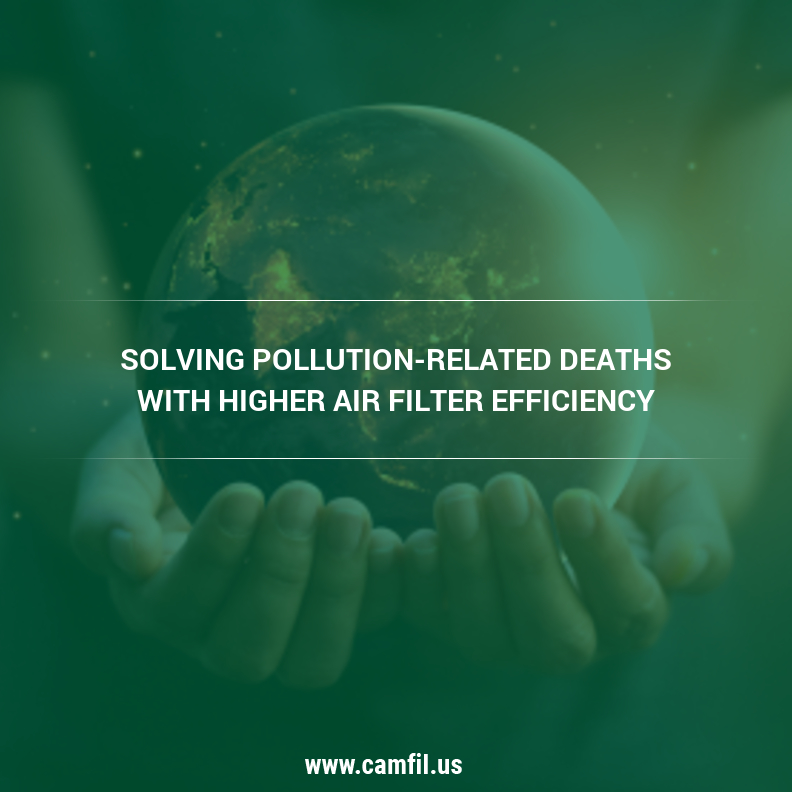Air pollution that affects outdoor & indoor air quality is estimated to shave 1.8 years off the average person’s lifespan. Learn how high efficiency air filters can help.
According to a team of researchers, air pollution generated by the rampant burning of fossil fuels is literally shortening the average lifespan of people, taking away 1.8 years per person. In fact, the same report states that air pollution is the world’s top killer, making the case for installing air filters for commercial buildings or homes even stronger.
Furthermore, air pollution exposure is more dangerous than second-hand cigarette smoke, which can reduce the average lifespan by 1.6 years. In terms of impact on lifespan, air quality also trumps serious public health threats such as HIV/AIDS and social issues such as conflict and terrorism.
In response to the growing threat of air pollution, researchers from the Energy Policy Institute at the University of Chicago have created a new system for measuring the impact of air pollution on public health. The Air Quality Life Index (AQLI) quantifies the effect of air pollution on life expectancy, telling users how many years of life they would lose due to air pollution depending on which particular region of a country they live in.
Particulate Matter Cited as Most Damaging to Outdoor and Indoor Air Quality
It’s estimated that 75 percent of the world’s population, or roughly 5.5 billion people, live in parts of the world where concentrations of particulate matter pollution exceed the World Health Organization (WHO) guidelines. According to the AQLI’s accompanying report, India and China, where 36 percent of the global population lives, account for a whopping 73 percent of all years of life lost due to poor outdoor and indoor air quality caused by particulate matter (PM).
If the Indian government were somehow able to cut particulate matter concentrations in the country, it would expand the national average life expectancy by four years, or from 69 to 73 years.
In the United States, on the other hand, it’s estimated that around a third of the population lives in places where air pollution sometimes exceeds the WHO’s guidelines. Those living in the most polluted counties and cities, like Los Angeles and Bakersfield, can expect to live at least one year longer if air quality was improved.
Rampant Burning of Fossil Fuels Highlights Need for High Efficiency Filtration Systems
Unsurprisingly, the use of fossil fuels for transport, industry, and power generation was cited as the primary cause behind the global air pollution crisis. It’s also why governments around the world are requiring homes, buildings, and businesses near air pollution hotspots, such as industrial zones and major roads, to install high efficiency filtration systems that can capture and remove particulate matter down into the sub-micron size range.
“Combustion generates H2O, NO, NO2, CO, CO2 and particulate [matter],” said Camfil USA’s Charlie Seyffer, Manager of Marketing & Technical Materials for commercial air filters and 37-year ASHRAE member and active committee participant. “Impurities such as metals, mercaptans, sulfur oxides, and other particles can be emitted. Some of the particles are large and settle out, but the majority of the particles are submicron and remain suspended in the air for long periods of time.”
The Link between Climate Change and Home Air Filtration Systems
As climate change continues unabated, scientists expect that the problem of air pollution will also worsen, driving demand for solutions such as home air filtration systems.
Climate change will create colder winters and hotter summers, the latter of which will exacerbate wildfires and droughts and particulate matter pollution from wildfire smoke and windblown dust to form smog in the atmosphere. Rising temperatures and an increase of carbon dioxide in the atmosphere will also make pollen seasons longer, increasing the amount of pollen produced by plants, in turn, making allergy attacks more frequent for allergy sufferers.
Aside from air pollution, climate change will threaten public health due to extreme heat, lower harvest yields, poor water quality, and population displacement.
Home Air Purifiers are an Important but Albeit Temporary Solution
While home air purifiers provide an efficient way to capture and remove particulate matter from indoor spaces, these solutions are ultimately stopgap measures that don’t address the source of pollution. This is why efforts to develop renewable energy sources, green technologies, and sustainable practices are so important.
Some air purifiers are available with HEPA filtration, the most efficient particulate filter available, and a molecular filter to remove gases and odors. You should always consult an air quality professional who will investigate the size of the room, the contaminants of concern and what type of system serves your heating an air conditioning needs.
Work with a Trusted Air Filter Manufacturer or Distributor
When shopping for commercial or industrial air filters, it pays to look for a trusted air filter manufacturer or distributor. With more than 50 years of experience designing and manufacturing high-quality air filter systems for a wide range of applications, including commercial buildings, schools, and airports among others, Camfil USA is proud to help people solve their air quality problems.
Talk to our team to learn more about improving your home or building’s indoor air quality with the best air filters available that fit your needs. You may also browse through our catalog collection of industry-related air filters to learn more about our clean air solutions.
Lynne Laake
Camfil USA Air Filters
T: 888.599.6620
E: Lynne.Laake@camfil.com
F: Friend Camfil USA on Facebook
Y: Watch Camfil Videos on YouTube
Source:
The post Solving Pollution-Related Deaths with Higher Air Filter Efficiency appeared first on Air Filters for Clean Air.

